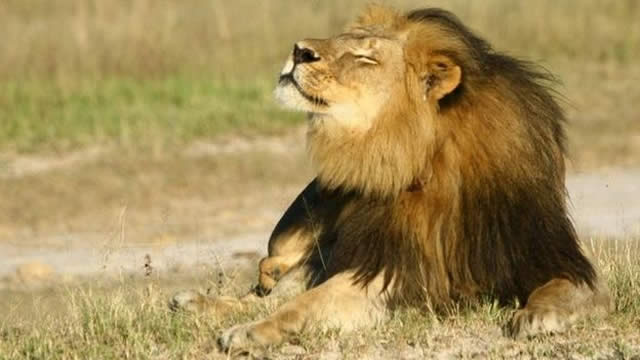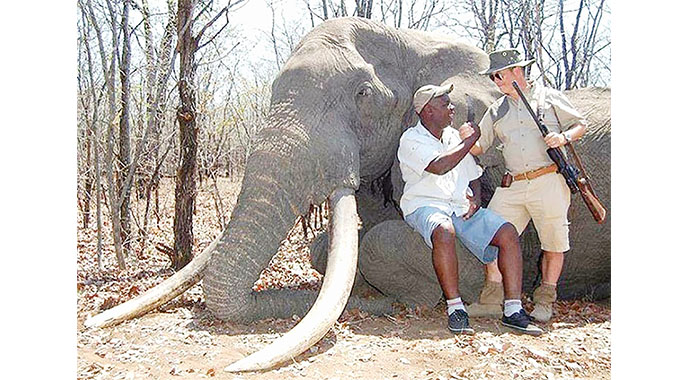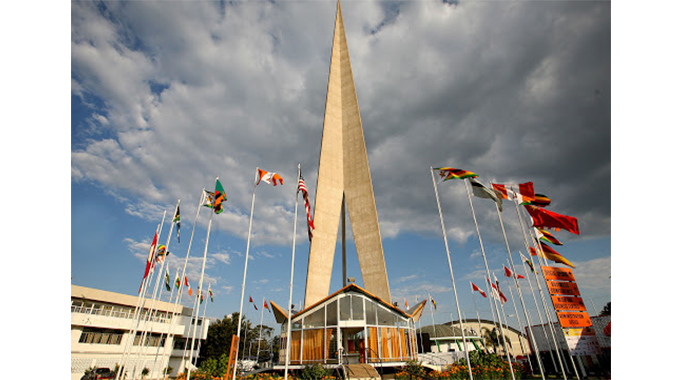Trophy hunting: In memory of Cecil the Lion (2002- 02/07/2015)

Maita Zizhou, Online Reporter
AS the British historian James Anthony Froude once wrote: “Wild animals never kill for sport. Man is the only one to whom the torture and death of his fellow creatures is amusing in itself.”
Throughout history, the manes of male lions have evoked admiration and fear.
However, one majestic lion comes to mind when I hear about black-maned lions… Cecil. The mighty and majestic Cecil- one can even call him the Apollo of the species- was the black-manned lion who roamed the Savannah plains of the biggest national park in Zimbabwe, Hwange National Park. Cecil was a force of nature, controlling a powerful pride of 16 lions and the Somalisa Concession.
The mane of a lion is the long hair that grows around its head, neck, and shoulders. However, a mane is not always a defining feature of all lions. For instance, in Kenya the Tsavo National Park has lions that are largely mane-less. The mane of a male lion is usually longer and thicker than that of a female.
Black-maned lions are a rare breed. A lion’s mane is a visual indicator of a lion’s health, a darker and fuller mane indicates superior health and physical strength. As a result, male lions with darker and fuller manes are more desirable to female lions which means Cecil the lion was a top-of-the-class breed.

Cecil the Lion
They are more likely to pass on their genes. Rather than talking about Cecil’s death we’re going to focus more on his life which many wildlife lovers have claimed he lived to the fullest. It is the legacy of a black-maned legend gone before his time and the shaky future of his cubs.
All my life, male lions have always inspired awe-filled admiration and fear because of their size, sheer strength, and intimidating roars that always send shivers down my spine. In addition, their powerful predatory Instinct and impressive ability to hunt down their prey further added to the respect and admiration I had for them.
Their impressive manes, protective nature, and their ability to work together as a pride to protect and defend their territory against other predators is another testament to the extraordinary inborn power and strength of male lions.
Lions are the apex predators of the African savannah and have a wide range of hunting techniques at their disposal. They have few if any, natural enemies. The lithe felines can stalk, run, climb trees, and possess an impressive set of sharp teeth and claws that can take down their prey easily.
Cecil the lion was the biggest male black-maned lion in Hwange National Park. Unfortunately, his unique look marked him for death and led to his untimely and unfair demise on July 2, 2015, at the hands of an American trophy hunter named Walter Palmer.
Besides his striking appearance, the big cat’s status as the king of the savannah made him an irresistible trophy to the American dentist.

Walter Palmer
To Palmer, snuffing out Cecil at his prime and taking him as a trophy was an achievement that he could boast about to his friends back home. He did not care that he had disrupted one of the lions’ greatest assets for survival- teamwork- in hunting and taking care of the pride. Taking out Cecil who was the leader and therefore a vital cog in the pride threatened its very existence.
Lions have a strong social system, with a hierarchy based on size and strength. As the king of the savannah, Cecil had a responsibility to protect his pride. Territorial lions defend their pride against intruders and predators. They mark their territory with their roar, and with urine and faeces, to let other lions know that this is their domain. Growing up right next to the national park, for me, a lion’s roar is as common as a traffic light in Bulawayo. It can be heard several kilometres away can make the small hairs at the back of the neck stand, because of its sheer intensity. Male lions also patrol their territory to make sure it is secure. Cecil’s death was a tragedy that highlights the need for conservation and protection of wildlife in the wild.
Cecil the Lion was two years younger than me as he was born in 2002 and I was quite fond of him. I had kept abreast with studies centred around him and his death came as a huge blow. I feel the loss we suffered as a nation and as a community, as I grew up in the tiny community of Dete which is part of the national park. Tourism in the National Park benefits the local community. It provides jobs and income for people living in the area. Cecil’s relationship with the Somalisa Concession residents was similar to an elder’s relationship with a family. His death was a devastating loss, as if a close family member had been taken away. Conservation efforts in Dete raise awareness about wildlife and habitats for future generations. Additionally, they bring much-needed resources to the community, including education, and housing.
African lions once roamed most of Africa and Asia and Europe. But the species has disappeared from 94 percent of its historic range and can only be found today in sub-Saharan Africa. The African lion is a species of large cats that are found in Africa. They are classified as an endangered species. Poaching for trophies and habitat destruction are two of the main reasons for the decline of African lions. As human populations increase, lions are losing their habitats and coming into conflict with humans over livestock. This has caused an increase in retaliatory killings of lions by humans.
Every year Africa suffers major wildlife losses as a result of poaching. Therefore, the protection of our endangered wildlife ensures our natural environment and biodiversity are preserved for future generations. With Cecil’s death, the Hwange National Park lost a whole dynasty of magnificent black-mane lions that could have strived under his care. Cecil’s cubs had their fate determined when their father was killed, as male lions that take over prides after the death of a leader, kill cubs that don’t belong to them to eliminate competition. Protection of our wildlife also ensures the continuation of species and habitats necessary for human well-being. Protecting wildlife not only safeguards the planet’s biodiversity, but also preserves the legacy of species like Cecil for future generations.

File Picture: Trophy hunters who patronise Dumazulu Safaris
The average lion weighs around 189kg (418 lbs.), but Cecil weighed 220kg (485 lbs.), which gave him the moniker of “the biggest lion in Zimbabwe”. Cecil wasn’t scared of humans. He would cut a picturesque figure- that got tourists snapping away memento photos and attracted them into the country in droves- as he placidly sat in the middle of a safari track. He would force safari vehicles to drive off the road and around him. Like a talented showman, he gave visitors a rare chance to be up close and personal with the feared predator, and made Zimbabwe a must-visit for people from other continents who had never seen a live lion before. They had to drive off the road in order to avoid him. His size and lack of fear towards humans made Cecil an iconic figure in the Zimbabwean wilderness, and his legacy continues to be remembered by both locals and tourists. Visitors had the opportunity to see him within touching distance, which must have been an awe-inspiring experience. In death, Cecil remains a wildlife ambassador for Zimbabwe.

A trophy hunter and his guide pose next to their kill
At the time of his shooting, Cecil was being studied by Oxford University researchers at Zimbabwe’s famous Hwange National Park. Cecil jointly led two prides containing numerous lionesses and cubs, all of whom were affected by his death. Most African wildlife suffers from illegal poaching every year. National Geographic estimates that trophy hunters kill approximately 600 lions every year. This highlights the need for tighter regulations on trophy hunting, as well as improved enforcement of existing laws. It is estimated that there were 92 054 lions in Africa in 1970. Lion populations have decreased by 75 percent over the last five decades which roughly is a decline of 1 400 lions per year, according to research by Four Paws. Trophy hunting impacts beyond the individual animal and has proved to have a negative effect on lion populations, as it can disrupt pride social structures, leading to a decrease in genetic diversity and cub survival rates.
Zimbabwe has made substantial strides in ensuring wildlife protection, for example, in 2005, Zimbabwe put a ban on lion trophy hunting, which was lifted in 2008. However, in response to Cecil’s killing and another illegal hunt, the country suspended the hunting of lions, leopards, and elephants near Hwange National Park. It had also suspended bow hunting. The ban was partially lifted in 2015. Two private game parks and the rural communities near them remain banned. This shows Zimbabwe’s commitment to wildlife protection and highlights ongoing efforts to ensure the safety of endangered species. In the areas where it has been rescinded, all lion, leopard and elephant hunts must be supervised by park staff. In addition, strict regulations have been implemented for these hunts, such as bag limits and restricted hunting seasons, ensuring that poaching and illegal hunting activities are kept to a minimum.









Comments